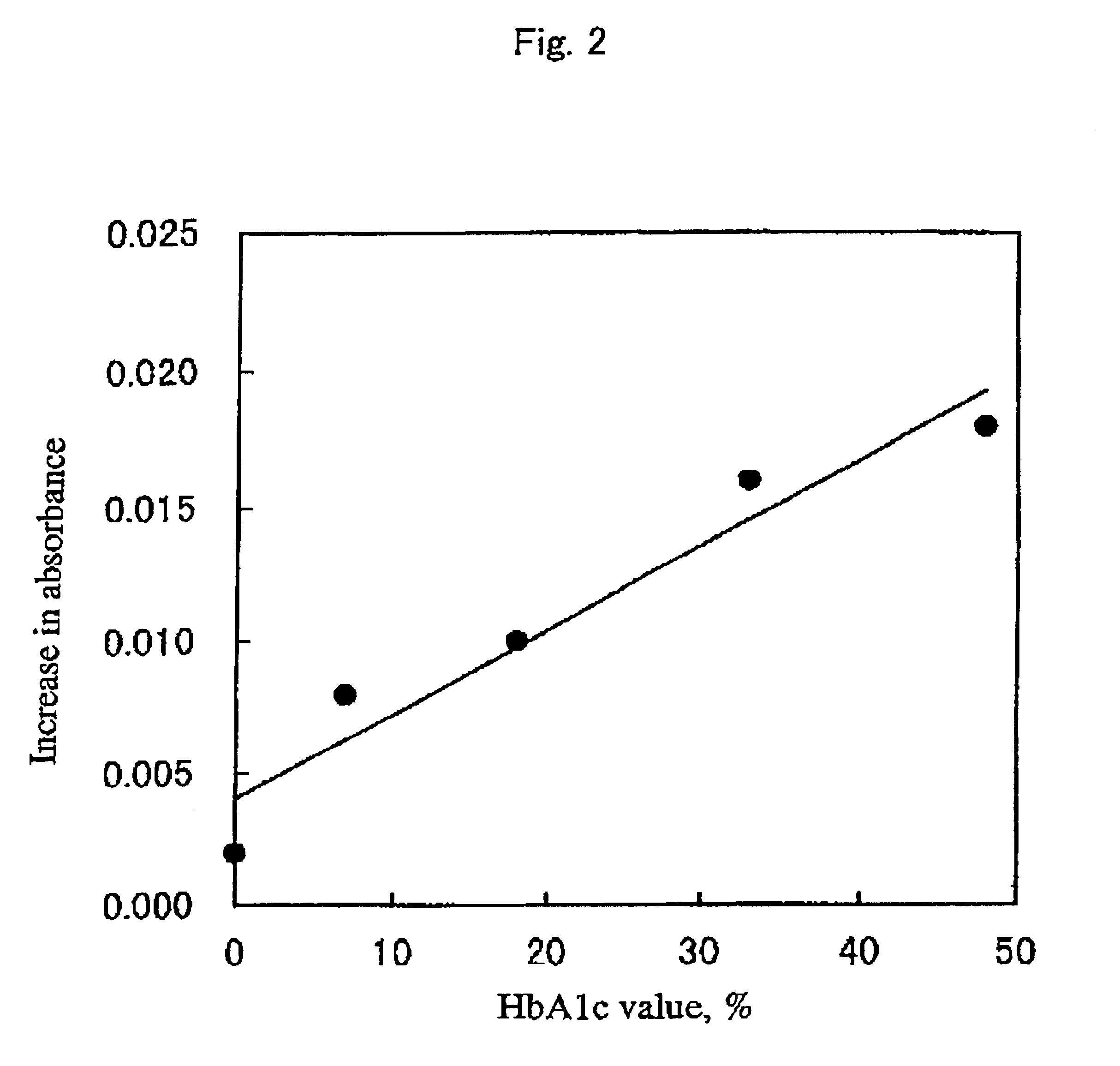Method for assaying glycated protein
a glycated protein and assay method technology, applied in the field of assaying glycated proteins, can solve the problems of inability inability to decompose glycated proteins to quantitatively liberate glycated amino acids, and inability to achieve -glycated amino acids, etc., to achieve high accuracy, short time period, and simple procedure
- Summary
- Abstract
- Description
- Claims
- Application Information
AI Technical Summary
Benefits of technology
Problems solved by technology
Method used
Image
Examples
example 1
Liberating Glycated Dipeptide from Glycated Hexapeptide
[0064]Treating glycated hemoglobin (HbAlc) with endoproteinase Glu-C results in liberation of an α-glycated hexapeptide derived from the β subunit of glycated hemoglobin (HbAlc) (fructosyl Val-His-Leu-Thr-Pro-Glu) (Clin. Chem., 43, 1994-1951 (1997)). Therefore, the following experiment was carried out using fructosyl Val-His-Leu-Thr-Pro-Glu (PEPTIDE INSTITUTE, INC.), which is identical to the α-glycated hexapeptide.
[0065]The α-glycated hexapeptide (PEPTIDE INSTITUTE, INC.) was dissolved in water to prepare a 5 mM solution. To 0.1 mL of this solution were added the following combinations of 0.01 mL of protease solution (20 mg / mL) and 0.09 mL of buffer (0.1 M) ((a) to (d)), followed by mixing to subject to protease treatment.
[0066](a) Carboxypeptidase Y (Oriented Yeast), a phosphate buffer (pH 6.5).
[0067](b) AO protease (commercially available from Seishin Corporation), a citric acid-sodium phosphate buffer (pH 6.0).
[0068](c) Pept...
example 2
Liberating Glycated Dipeptide from Glycated Protein
[0071]Distilled water was added to a glycated hemoglobin (HbAlc) control (International Reagents) to prepare a solution of 8 g / dL (HbAlc contact of about 10%). To 0.05 mL of this solution were added 0.01 mL of protease derived from the genus Aspergillus (Molsin, 20 mg / mL) and 0.04 mL of buffer (0.1 M, citric acid-disodium phosphate buffer, pH 3.0), followed by mixing. The mixed solution was treated with protease at 37° C. for 180 minutes. Thereafter, the reaction mixture was subjected to centrifugal filtration using Microcon 3 (fraction molecular weight 3,000 Grace Japan K. K.) and the filtrate was diluted and then assayed by HPLC as described in Example 1. The liberation of fructosyl Val-His was confirmed and the glycated dipeptide was determined based on the area of the elution peak. The glycated protein was assayed using the measured value.
example 3
Obtaining the Modified Oxidase of the Present Invention
(1) Preparation of template DNA
[0072]Escherichia coli DH5α, which maintains a plasmid (pFA5) coding for a fructosyl amino acid oxidase genes derived from a bacteria belonging to the genus Corynebacterium (FERM BP-6182), was inoculated into 100 mL of LB-amp medium (1% bactotrypton, 0.5% bactoyeast extract, 0.5% sodium chloride, 50 μg / mL ampicillin, pH 7.0), followed by shake culturing at 30° C. for 24 hours to obtain a cultured product. 1.5 mg of pFA5 plasmid DNA was obtained from the cultured product in accordance with the method described in “Molecular Cloning (2nd Edition, 1989)”.
(2) Introduction of mutation
[0073]30 μg of pFA5 plasmid DNA was dissolved in 100 μL of hydroxylamine solution (0.8 M hydroxylamine hydrochloride / 0.1 M phosphate buffer, pH 6.0 / 1 mM EDTA). The solution was subjected to mutation treatment at 65° C. for 2 hours and ethanol precipitation was performed by a conventional method to collect a precipitate. The...
PUM
| Property | Measurement | Unit |
|---|---|---|
| temperature | aaaaa | aaaaa |
| temperature | aaaaa | aaaaa |
| temperature | aaaaa | aaaaa |
Abstract
Description
Claims
Application Information
 Login to View More
Login to View More - R&D
- Intellectual Property
- Life Sciences
- Materials
- Tech Scout
- Unparalleled Data Quality
- Higher Quality Content
- 60% Fewer Hallucinations
Browse by: Latest US Patents, China's latest patents, Technical Efficacy Thesaurus, Application Domain, Technology Topic, Popular Technical Reports.
© 2025 PatSnap. All rights reserved.Legal|Privacy policy|Modern Slavery Act Transparency Statement|Sitemap|About US| Contact US: help@patsnap.com


